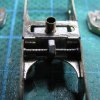Dave Holt
Western Thunderer
The cab inner frame has been folded up and loosely placed on the footplate.
Should be a fairly straight forward folding exercise but....The instructions warn to be careful not to distort local to the cab spectacle windows when folding the sides. This seems virtually impossible due to the lack of material to hold. So, despite using a hold-and-fold tool, the front plate did distort and had to be pressed back to shape afterwards. The other problem arose when I tried to place the cab structure on the footplate. The front of the floor interfered with the splashers and framework at the drop section of the footplate. To overcome this, as section of floor has had to be removed using a piercing saw. It would have been a lot easier to do this in the flat rather than with the folded up cab. I wonder if anyone else has experience this, an error in the kit or have I done something significantly wrong?
Cab frame placed loosely on the footplate. Those rearward projections at the top of the sides aren't half vulnerable!

Rear end of the footplate, showing the splashers and support frames that the floor interfered with.

Cab frame with the floor cut away, after folding, to clear the footplate.

Dave.
Should be a fairly straight forward folding exercise but....The instructions warn to be careful not to distort local to the cab spectacle windows when folding the sides. This seems virtually impossible due to the lack of material to hold. So, despite using a hold-and-fold tool, the front plate did distort and had to be pressed back to shape afterwards. The other problem arose when I tried to place the cab structure on the footplate. The front of the floor interfered with the splashers and framework at the drop section of the footplate. To overcome this, as section of floor has had to be removed using a piercing saw. It would have been a lot easier to do this in the flat rather than with the folded up cab. I wonder if anyone else has experience this, an error in the kit or have I done something significantly wrong?
Cab frame placed loosely on the footplate. Those rearward projections at the top of the sides aren't half vulnerable!
Rear end of the footplate, showing the splashers and support frames that the floor interfered with.

Cab frame with the floor cut away, after folding, to clear the footplate.

Dave.



















